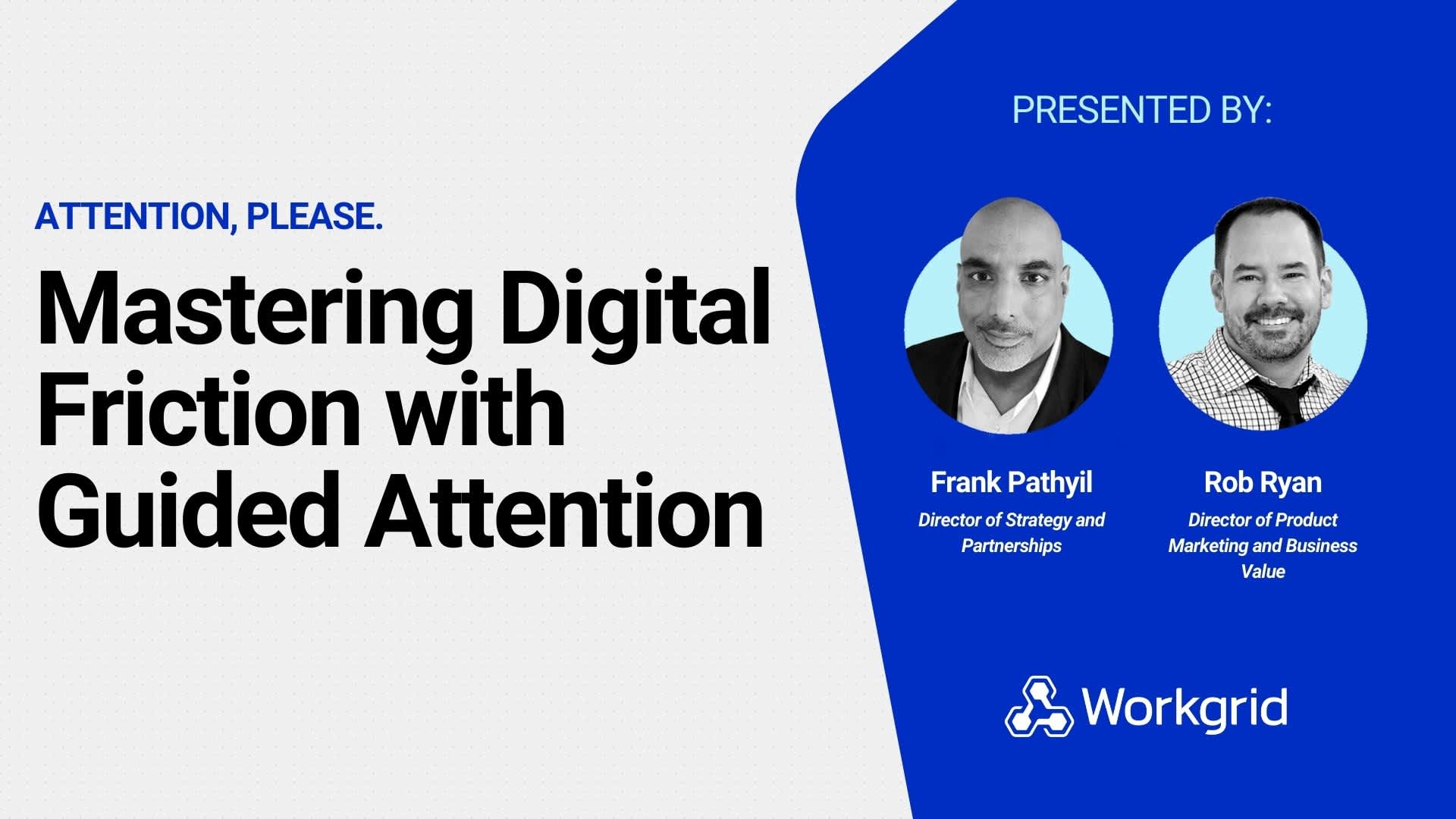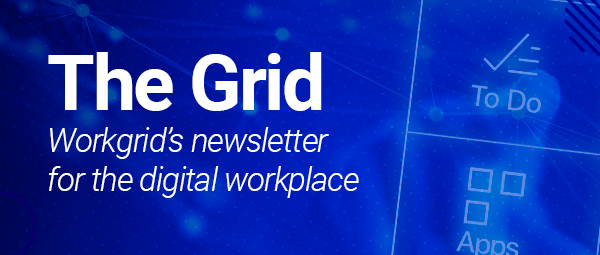This month, Rob Ryan, Workgrid’s Director of Product Marketing, presented at the Gartner Digital Workplace Summit. The presentation focused on understanding digital friction and shared stories on how world-class organizations have created frictionless experiences using intelligent technology and AI in the digital workplace.
Here’s a recap summary of what we covered!
The State of the Digital Workplace
We all know that the way we work has changed drastically over the past few years as the pandemic accelerated both business and digital transformation – and today we are seeing the downstream impact on our workplace. Things like remote and hybrid work, increased virtual collaboration, and real estate divestment have all become the new norm. They have also continued the fragmentation of the digital workplace.
This fragmentation has accelerated the pain of the modern work environment.
Here’s a fact that perhaps dawned on you in your early 20s or 30s... Your life is a triumvirate of thirds:
1/3 of our life is spent sleeping
1/3 doing the things you want to do
1/3 of your life working
But over 50% of working time is wasted, grinding against technology that was supposed to improve lives. According to the Harvard Business Review employees waste half their day context switching, on average up to 1200x a day. At first glance the idea of 1200 screen changes a day seems impossible to fathom but this is what it looks like.
![[asset] digital-friction-enterprise-technology](https://images.ctfassets.net/z7p73u8c0thn/4sp4xqZ5M6G4T8JGR6Yy7A/5cf3563540eb4ca963c10ae4b153bbb4/digital-friction-enterprise-technology.png?w=1200&h=673&q=60&fm=png&bg=transparent)
Our relationship with work technology has deteriorated. Employees are working for the tech, and not the other way around. This digital friction impacts our employee experience, our relationships, and our health.
But it doesn’t have to be this way. It’s about leveraging the latest tools and platforms to enhance our work, while also prioritizing our well-being and relationships with our colleagues.
How Digital Friction Impacts Work
If communications and key information is missed that should have been read, understood, and consumed, the result is less strategic alignment, lower trust, and lower engagement.
If time is wasted app hopping, context switching, and waiting for approvals, it leads to a decrease in productivity, flow, speed in decision making, and continues to erode our ever-decreasing attention span.
And if we continue to bombard employees with too many notifications, pings, dings, alerts, and hide information away, where they spend the majority of their time grating against workplace technology, it will kill motivation, lower employee experience, and increase stress.
Why Isn’t Digital Friction Addressed?
You may be asking, if this is such a big problem why aren’t organizations working toward a solution? Here are a few reasons:
Learned Helplessness – This is how we’ve always done things
No One's Job – There is no clear owner
Walled Applications – Technology is acquired in silos with different departments owning differing technologies
Competing Internal Priorities
The Frictionless Digital Workplace
At Workgrid we believe there is a better way of working. The way we get there is by effectively managing the friction of the day which starts at the cascade of backend systems. Workgrid helps to cut through this clutter by connecting to the everyday business apps you already use and surfacing the information and tasks employees need to know and take action on.
To get started with removing digital friction, we recommend beginning with optimizing the delivery of key systems. What are the technologies employees frequently access? Things like time-off balance, pay data, office alerts, or procurement and travel requests are a great place to start.
Prioritizing the delivery of the information from these systems, into the channels in which your employees work, helps to remove the unnecessary context switching that decreases productivity throughout the day.
Imagine a digital workplace in which in the few minutes before your next meeting you could accomplish several tasks...
What if you could just find out your new chair is coming versus going to ServiceNow to read it?
What if you could just OK your employee’s day off instead of navigating all the way into the system?
What if you could find out that learning has something new and interesting?
What if the system could slip in a reminder to take a day off?
What if you could quickly check your paystub was updated to show your new 401K approach?
…and this was all done before your coffee was fully brewed?
Workgrid is your new Digital Assistant
The Workgrid digital assistant guides attention, action, and engagement - bringing information into the channels you work in – like the intranet or within your collaboration suite like Microsoft Teams. The digital assistant presents personalized tasks, and information from across the organization alongside important employee data, like pay slip information and time off balances.
To Knows create a personalized, contextual news feed that includes global news,
as well as news targeted by location, Strategic Business Unit, job function, etc.
To Knows also deliver proactive alerts from source systems such as Oracle HCM
to notify employees about preferred information, such as job postings.
To Dos create a unified notification stream for systems like Workforce, Chrome River,
and SAP Ariba. This enables workers to view and act on routine tasks that need their attention
from across the enterprise, such as approving vacation requests and expense reports.
Microapps give employees seamless access to the specific functionality they need from
core enterprise systems like Workforce, SAP Fieldglass, and Power BI, right from the intranet.
This makes it easy to view pay slip and time off data, assign tasks, view talent metric reports and more
Customer Stories
Optimizing for App Overload
A few years back, Liberty Mutual Insurance – our parent company – began to understand that digital friction was becoming a growing irritation to employees. They looked at the common challenges organizations face: cognitive overload, delayed approvals, ignored or unconsumed communications etc. and they looked at the root causes—
Missed communications
Too many login screens
Too many notifications
Multiple step approvals in third-party systems
Multi-step workflows
App hopping
Information overload
Liberty Mutual realized that they could fix these challenges; and if they can address the root causes one by one, they could deliver a far great employee experience. They stepped back to understand the problem deeply and defined a vision for the future state, one which looked frictionless and felt engaging. They began slowly mapping to an NEW Future…
One that put the employee at the center of the employee experience.
Today, Liberty Mutual Insurance uses Workgrid to optimize the employee experience by integrating the most important tasks and information into a single multichannel interface. This helps employees work more efficiently because they can access key resources and information without the need to log-in or app hop into another system.
Overcoming Information Overload
Let’s take one of our customers, a Fortune 200 CPG, plagued with digital friction and looking for a better way to work. Their first step was understanding the persona, conducting studies to gain a better sense of the day in the life of a field rep, understanding the routine systems, processes, and interactions with customers.
What they found was employee starts their day in the office at a workstation getting ready for their meetings of the day required the reps to access multiple systems, logins, wading through too much information and records. They would need to manually research any business condition changes, product and pricing changes that may have impacted their accounts.
The analysis concluded that context switching and archaic process decreased productivity. The reps were then using an outdated methods, processes, printing any documentation such as pricing sheets and sku sheets and hand carrying these on site to meet with the customer.
This caused various miscommunication and inefficiencies and lower customer satisfaction – with unknown loss of revenue.
Using Workgrid, the company was able to arm their field sales team with a multichannel digital assistant. They could start their day getting a holistic sense of upcoming events, meetings, news and alerts or leads, product updates, sales KPIs, and communications and information related to changing business conditions. With streamlined access to the tools and resources they needed to best serve their customers, each sales rep could receive personalized information for their accounts including key product and pricing changes tailored to their book of business through the digital assistant.
These changes and access to info could be access and delivered intelligently, ultimately leading to greater customer satisfaction and increased quota attainment per rep.
Minimizing Noise
A non-profit organization in the education sector uses Workgrid to guide employee’s attention to minimize the noise created by a plethora of third-party system pings, dings, and notifications. This helps reduce the distractions that pull employees out of the flow of their work. It also aides in giving employees a more effective way to find pertinent information and research answers, resources, and policies with the use of the Workgrid Chatbot.
Prior to the use of Workgrid, employees used a Slack channel to post queries and questions to more than 1,600 network members. It was a process akin to yelling questions in a crowd and expecting a valid response - highly inefficient and riddled with flaws, with no way to validate answers or even determine what was considered an official response. The process became a significant distraction for all members. The abundance of pings was a notifiable drain on the productivity of the person seeking the information, and everyone else who had to assess the flood of questions and responses received.
Leveraging Workgrid’s natural language chatbot, the organization will be able to eliminate this detrimental incursion of peer-to-peer questions. The chatbot will become a destination that gives employees personalized, contextual answers to routine questions. Once populated with the most common questions, responses, and actions, it will become a single source of truth for information from across the business, estimated to save the business more than $1million each year, between productivity time-savings and deflection of costly help & support tickets.
AI + Guided Attention Technology
As we look to the future, AI will play even more of a role in these digital work experiences. Take for example the role of a manager. They are often bogged down with tasks like approvals. Experiences driven by artificial intelligence can help reduce digital friction and aid in the speed of completing these managerial tasks.
Typically, a time off request may come to the manager buried deep in an email inbox. The manager would see the request notification, log into the time management system to view the details, switch back to the calendar to see what other team members may be off that day, and navigate back to the system to approve or reject the request.
In the example below, Linnae has requested time off. In the background the digital assistant fetches the request, determines the best possible time to send this notification to the manager based on urgency and calendar. Then it checks the team members' PTO scheduling to see if there are any other folks who have time off, providing the manager with a breadth of detail to help them review, approve, reject, or snooze in just a click.
![[asset] time-off-ai-example](https://images.ctfassets.net/z7p73u8c0thn/4lj4VF6PXTwNFzeSANvdAN/85e261be9ce459a3fc30978958194661/time-off-ai-example.png?w=1200&h=447&q=60&fm=png&bg=transparent)
Another example of intelligence in action is workplace travel. Perhaps an employee has upcoming travel scheduled and to help prepare, the digital assistant delivers travel insights directly to them. Not only will it remind the user of their upcoming travel, but provide internal office information, such as requesting badge access and meeting room details. These sorts of experiences remove burdensome information finding by using guided attention technology to surface what employees’ need to know.
Closing Thoughts
The world has changed – but people have not. If workplace leaders can step back, understand the work day and the world as it appears to our employee, we can reduce the digital friction from their day giving them back time, attention, and focus.
In the end we can create digital workplaces that foster the type of employee experience we all want, modern, personalized, and human centric.




